The 5 Worst Winter U.S. Locations of 2018-19
By Jonathan Erdman
March 19 2019 02:00 PM EDT weather.com
Winter 2018-19 is officially over, and for five locations in the United States, it isn't a moment too soon.It would seem formidable to narrow down and rank five places that had it worst this winter.
It was so challenging we had to reluctantly leave both Caribou, Maine, where almost 60 inches of snow fell in one month, and Michigan's Upper Peninsula, where residents struggled to keep snow-buried streets open, off our list.
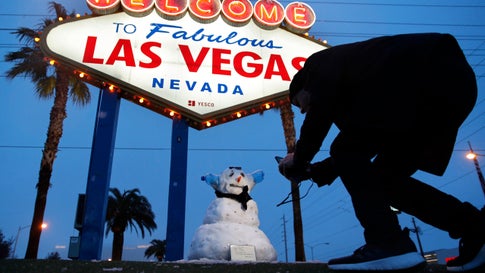
A
man, who declined to give his name, takes a picture of a small snowman
at the "Welcome to Fabulous Las Vegas" sign along the Las Vegas Strip,
Thursday, Feb. 21, 2019. Winter Storm Quiana dumped the first measurable
snow at McCarran Airport since Dec. 17, 2008.(AP Photo/John Locher)
We admit the list is at least somewhat subjective, ranking the worst winter weather relative to what each location is used to. The colder and snowier than average, the better chance it made our list.
But this isn't just a list solely about snow and cold.
Three of the five locations made our top five for reasons not entirely from persistent cold or heavy snow.
5. California
California suffered through its worst fire season on record in 2018, including its deadliest and most destructive fire, which destroyed the town of Paradise; its record largest wildfire, the Mendocino Complex Fire; a fire-tornado-spawning wildfire in Redding, California; and the Woolsey Fire in L.A. and Ventura counties, among others.Rain-triggered debris flows trapped residents and vehicles and triggered evacuations just weeks after the Camp Fire scorched through Butte County, including the town of Paradise.
Storms in early December and mid-January also triggered some mudslides and rockslides in both Northern and Southern California.
The worst of the flooding, however, was in late February, when the Russian River reached its highest level in 25 years, isolating the towns of Guerneville and Monte Rio. Over 2,000 homes and businesses were damaged, and nearly 4,000 residents were ordered to evacuate Guerneville.
(PHOTOS: Aerials | Post-Storm Damage)
This wet siege wasn't all bad news for California, as we'll discuss below.
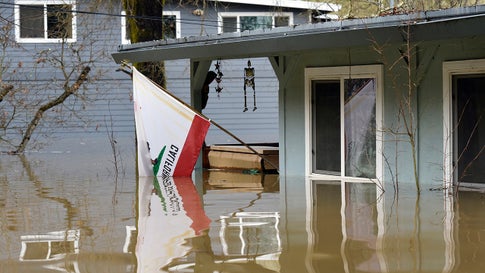
A
California state flag hangs from the front of a home submerged in the
floodwaters of the Russian River in Forestville, California, on
Wednesday, Feb. 27, 2019. The Russian River was engorged by days of rain
from western U.S. storms.(AP Photo/Michael Short)
4. Seattle
You might think this is an odd pick. How bad can a winter be in a place that averages only 5 to 6 inches of snow a year?From Feb. 3 to 12, Seattle picked up 20.2 inches of snow from three separate winter storms. In just nine days, the Emerald City measured almost four times their average annual snowfall, making February 2019 only the eighth month on record in which the city picked up at least 20 inches of snow – the first such month since January 1969.
While children celebrated snow days, each of the three storms snarled traffic, led to hundreds of flight cancellations and downed trees, triggering power outages.
Not to be outdone, Eugene, Oregon, which averages only about 4 inches a year, picked up a whopping 18.8 inches of snow from Feb. 24 to 27, downing trees and power lines and stranding an Amtrak train for 40 hours in the mountains outside the city.
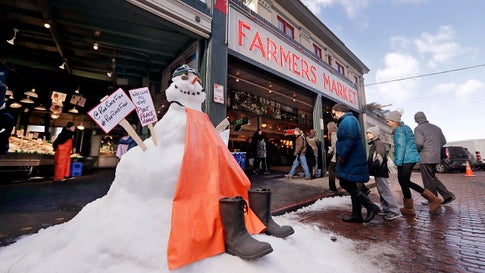
A
snow sculpture is dressed as the fishmongers working behind as people
walk into the Pike Place Market in near-freezing weather Tuesday, Feb.
5, 2019, in Seattle. Winter weather closed schools and disrupted travel
across much of the West, with ice and snow stretching from Seattle to
Arizona.(AP Photo/Elaine Thompson)
3. Tennessee
In America's wettest winter on record dating to 1895, Tennessee was the only state to set a record-wet December-through-February period, according to NOAA.The Volunteer State also set its record-wet February for the second year in a row. Nashville and Knoxville topped their previous February precipitation records that had been in place since 1880 and 1873, respectively, picking up over 13 inches of rain.
Swamped roads, mudslides, landslides and even a sinkhole resulted from multiple heavy rain events in February.
This wasn't simply a story in Tennessee; Tupelo, Mississippi, and Huntsville, Alabama, also had a record-wet February. States of emergency were declared in Kentucky and parts of Mississippi for flooding.
"This winter ranks among the worst I've experienced in recent memory in the South," said Chris Dolce, a senior meteorologist at weather.com and a resident of the Atlanta metro area.
"If it wasn't raining, it was cloudy."
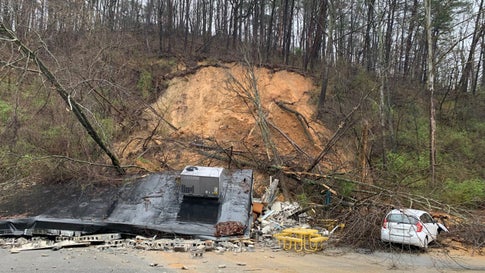
A
landslide took out a Subway restaurant on Signal Mountain Blvd. in
Chattanooga, Tennessee, on Saturday, Feb. 23, 2019, as heavy rain soaked
the South. (Twitter/@ChattFireDept)
2. Montana
In winter 2017-18, we gave the worst winter title to Havre, Montana, in what was a relatively easy decision. Big Sky Country was nearly a repeat champion.After Groundhog Day, Great Falls, Montana, had a streak of 44 consecutive colder-than-average days through March 18, when this column was written. On March 3, the day's mean temperature – basically, an average of the day's high and low – was 50 degrees colder than average.
It was the state's second-coldest February on record, exceeded only by the record-shattering 1936. In March, one location dipped to minus 46 degrees, a new preliminary all-time March record for the state, pending further investigation.
The persistent cold pushed the frost level so deep into the ground that it froze water lines leading to some homes in Bozeman, Great Falls, Helena and Missoula, leaving some residents without running water for an extended period.
Billings, Bozeman, and Great Falls each had a snow surplus of at least 20 inches for the season through March 18. Billings was pushing toward a record number of days with measurable snow in a season. In mid-March, Missoula set records for the heaviest snow depths so late in the season, with 7 inches on the ground on March 18.
By March, the weight of snow was too much for some buildings. A roof collapsed at a Montana State University fitness center in Bozeman, and a vacant building's roof also caved in downtown Missoula.
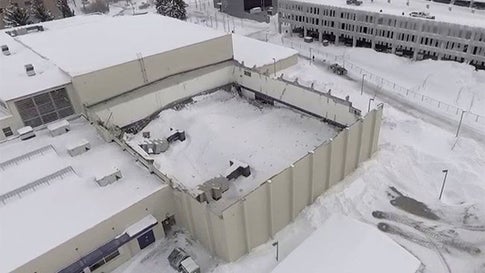
In
this Thursday, March 7, 2019, still image taken from video provided by
Montana State University News Service, part of the roof at a Montana
State University fitness center in Bozeman, Montana, has collapsed.
(Montana State University News Service via AP)1. Nebraska
We were ready to hand Montana its second straight worst winter title. Then, mid-March pushed Nebraska to the top of this list.Even before that storm, Omaha not only smashed its record-snowiest February (27 inches), but also their snowiest winter (46.1 inches from December through February). Blizzard conditions with snowfall rates up to 4 inches per hour hammered the city during Winter Storm Quiana in late-February.
The Cornhusker State's eighth-coldest February was followed by another cold outbreak, with temperatures as low as the minus 20s – among the coldest March temperatures on record in Nebraska.
Then came an epic flood.
A rare confluence of factors, including rapid snowmelt, then soaking rain from the mid-March bomb cyclone, sent rapid runoff into rivers previously frozen from the exceptional cold, triggering record floods in 20 Nebraska locations, as well in parts of Iowa, South Dakota, Minnesota and Wisconsin.
The ice-choked Niobrara River in northern Nebraska burst through and destroyed Spencer Dam, sending a wave of water and massive ice slabs into towns and fields.

